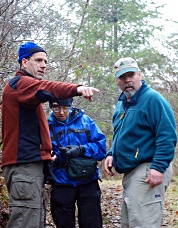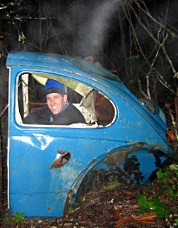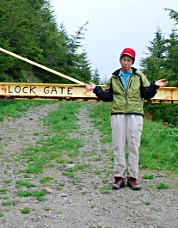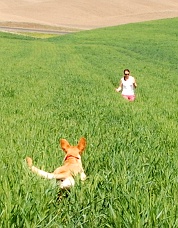 |
 et the Bottom Scrapers Speak et the Bottom Scrapers Speak
The foregoing definition says nothing about why some of us find dumpster diving so satisfying. Let’s see what my asylum mates are all about.
Stefan Feller is probably the most ardent dumpster diver among us.
He’s done more dives than anybody and he’ll get up really
early in the morning to dive before work. It’s not unusual for
Stefan to get up at 3:00 a.m. and drive for more than an hour, then
maybe hop on his bike for an hour, eventually finding his summit
(sometimes while it is still dark), and then return to his desk at work
in Renton by 8:30 a.m. Now that’s dedication! Of course, Stefan
has pretty much done everything close to his home and office by now so
the regularity with which he gets up early for diving exercise has
diminished. Or he simply gets up even earlier.
“I do not look at it as dumpster diving. I look at it as
peak bagging. My climbing goal is to get to and summit as many different
mountains as I can. I can’t tell you why so many different
mountains have allure to me except that I know I have one life and I
would like to experience as many different points on this Earth as I can.
Sometimes you get quality peaks along the way and sometimes you have to
stretch the definition of a mountain. Many people climb one peak or
another because it has been named. I do not discriminate between unnamed
and named peaks. I don’t even discriminate based on their height.
“I have decided that all high points with at least 400ft of
prominence shall be included in my peak bagging. Even the so-called
dumpster dives offer challenges. Many are behind gates and quite a few
are on gun-toting, dog-owning private property. So I say, do not
discriminate what constitutes a mountain. Be happy you are in a
continual pursuit of something that gives you energy in life.”
—Stefan Feller
 Paul Klenke and John Roper discuss the route in Fort Lewis while Fay Pullen checks the GPS. Photo © Michelle Rowley Klenke. |
|
 Approaching “The Cork” (2002ft) near Marblemount. Photo © Paul Klenke. |
|
 Trophy-sized bug on Green Mountain, Kitsap Peninsula. Photo © Michelle Rowley Klenke. |
| Paul Klenke and John Roper discuss the route in Fort Lewis while Fay Pullen checks the GPS. Photo © Michelle Rowley Klenke. |
|
Approaching “The Cork” (2002ft) near Marblemount. Photo © Paul Klenke. |
|
Trophy-sized bug on Green Mountain, Kitsap Peninsula. Photo © Michelle Rowley Klenke. |
The elder statesman of peakbagging in Washington is surely John Roper
(known as “the Rhino”). He was romping and stomping his
first dumpsters before many of us were born. Roper has reached so many
summits in Washington that now, to keep his climbing mind grinding away,
he salts it with a unique pursuit not even his asylum mates find
appealing: he bags quad highpoints (QHPs)—the highest point on
every quad. Talk about some potentially lame destinations!
“My first-ever summit was Little Si in 1953, at the age of
nine. Nowadays I guess this could be called a dumpster dive, but Little
Si is really more of a ‘blob’ than a ‘dive.’ The
difference is that a ‘blob’ is cute with a distinct and
somewhat attractive shape. Other Blob examples would be Fuller Mountain,
‘Young Love,’ Bald Mountain (the one by Lake Cavanaugh),
Cedar Butte, and ‘Toc Rock.’ If the landform looks like it
could have come out of an ice cream scoop, it’s a blob. A dumpster
dive has no redeeming aesthetic qualities, but they still get you out of
the house for some exercise and into the woods, often too much into the
woods.
“I climbed nothing but real mountains for the next 34 years
until 1987 when, on a year’s sabbatical from work, I set out to
visit and chronicle the named features in the Skagit River watershed,
and started poking around down by Skagit Bay, first with 934-ft Little
Mountain near Mount Vernon, then carrying on from there. Upon climbing
a few of these lesser summits, it became obvious that one could rack up
some good numbers on peaks climbed (in a year or a lifetime) by salting
in puny peaks with the real ones. ‘Quantity over quality’
became my mantra.” —John Roper
Then there is Fay Pullen, the asylum patient who escapes the most. If
it seems like Fay is out there twice a week that is because she is. But,
to her credit, she generally only does the dumpster thing in the
off-season (call it the “wet season” if you like; you
know—September to July here in western Washington).
“So why do I like dumpster diving? Well, golly gee
whiz—what’s not to like? I get to flex my 4X4 driving
muscles wandering barely passable unmaintained roads abusing my poor Jeep
in the process with scratches, dents, cracked windshields, and multiple
flat tires. Or I get to pedal (or push) my bike for miles up gated,
steep logging roads, usually in the rain, only to crash horrid, and
usually wet, brush to reach an insignificant low summit with no view
whatsoever whose high point, when it can be determined at all, is
frequently a ‘picturesque’ rotting stump or slash pile. But
hey, I get to make another checkmark on some obscure list.
“But the real fun of dumpsters is the challenge of finding a way
up by any means of travel that works, armed only with a map and
determination. Therein lies the lure. And if it can be done with or in
the footsteps of other demented divers, so much the better.”
—Fay Pullen
 Fay Pullen at Rooster Rock near Morton. The gate was locked. Photo © Paul Klenke. |
|
 Sofy making a mountain out of an ant-hill, Fort Lewis. Photo © John Roper. |
|
 Bagging the greatest prominence point in Franklin County, WA. Photo © Paul Klenke. |
| Fay Pullen at Rooster Rock near Morton. The gate was locked. Photo © Paul Klenke. |
|
Sofy making a mountain out of an ant-hill, Fort Lewis. Photo © John Roper. |
|
Bagging the greatest prominence point in Franklin County, WA. Photo © Paul Klenke. |
Beckey Aint Never Been There
I have noticed for myself that, since I became a dumpster diver, I
now view the world around me differently. I now find myself seeing
things I never saw before. High alpine peaks are often not visible from
valleys and roads. We don’t see them until we get higher up. But
these little dumpster peaks are frequently right there beside or in front
of me, next to the highway or filling up my windshield with their
forested hillsides. If I am traveling through a place I’ve been
through before, I can see these little peaks and know which ones they
are, and, if I have climbed them, I can say with contentment (or
sometimes with bemusement), “I’ve been up there” or
“I’ve done that one” to those in the car who might care
to know, which isn’t many of you.
If I am traveling through a place I’ve never been, I’ll
see a little summit and wonder if it “has prominence”
(≥400ft in Washington) and invariably ask myself how I would go about
getting up it. Is there a logging road? Is it on private property? Is
it cliffy at the top? It gives me something to think about when there
might otherwise be not much to think about on a boring road.
With dumpster diving, you never know what man-made oddity you may
discover, sometimes literally stumbling upon it. I’ve seen
everything from a rusty sheet metal rhinoceros to a fugitive’s old
hideout to cords of wood stacked in the middle of nowhere. I’ve
seen my share of gravel pits doubling as firing ranges. I’ve come
across squatters without guns and squatters with guns. I’ve done
summits crowded with old RV trailers. I’ve found my way onto many
dubious summits.
One difficult dumpster I have on my goals list is Jorgenson Hill on
Indian Island near Port Townsend. Jorgenson Hill is inside one of the
Navy’s ordnance depots. I have this notion of asking to be taken
up to the summit by MPs. I’d even do it blindfolded. There is
also Gable Mountain on the Hanford Nuclear Site. For this dumpster, my
plan is to write a letter to the site manager seeking a special one-time
permit to enter. There’s always a way.
Closing the Lid
In closing, I'll offer a continuation of Howbert’s report for
the day he and Roper snared Sares Head:
“Things were getting desperate. I looked out the window
again and it was still there, falling....rain, rain, and more rain. It
was the same almost every weekend for two months. November and December
in Seattle are meant to be wet and I’ve learned to love it and go
out anyway.
“The final two months of 1998 went into the record books as the
wettest November-December ever in Western Washington. They also went
into my personal annals as the lousiest end-of-year climbing season ever.
But this volume of rain, the droning consistency, was eroding my
determination. Heretical thoughts flickered through my
head…wouldn’t it be easier to stay home, stay more…comfortable?
“Yet my motivation still simmered, if on low heat. I had
dedicated the past year to a perverse quest: to bag as many peaks as I
could. And this would be my last chance to go out in 1998. How could I
resist pushing the total a little higher? I knew I wouldn’t come
this way again. What was another short round of misery against that
immortal goal?
“So I researched a few more maps for my Master List. Then I
tried to find company for the anticipated misery. I called the only
person I knew who wouldn’t laugh right away—the Rhino.”
—Jeff Howbert
I’m sure that Fred Beckey has never visited Sares Head. Neither
have I for that matter. Hmmmm…
|

|
| Taking The Plunge |
|
 |
| Washington's Dumpiest Dumps
|
 |
|
There are many regions in Washington crammed with dumpsters. I
won’t list where they all are, but a bit of common sense
and knowledge of state geography should tell you where to steer
clear of.
However, I will tell you where the ultimate dumpster dump is in
Washington. I’m not worried about you accidentally finding
yourself trapped there because it lies within the Fort Lewis Military
Reservation.
There are 96 named hills on the base. I have climbed 66 of these
named hills, including all 27 on the Nisqually quad. Most of them
are brushy and all have less than 200ft of prominence.
What’s more, these summits are often indeterminate in their
flat ridiculousness. But if you can rustle up some good company
while you’re out there it can be a fun experience trying to
find these summits.
You need to obtain a special permit just to enter the base. Then
you have to make sure that the sector you want to visit is actually
open to the public and not being crisscrossed at that time by
soldiers, bullets, or artillery shells.
There are even named hills in the center of artillery impact
areas that are never open, except by special hunting permit.
|
 |
| All In the Family
|
 |
|
My wife Michelle is new to climbing and has put up with my
“non-climbing” dumpster diving on numerous occasions.
She has an analogy that works well:
“Imagine growing up in Smallville where the only places to
shop are old strip malls with not the greatest selection of shops.
And then you move to a new state where the biggest and greatest
stores you only dreamed of shopping at are right in your
backyard.
Washington’s mountains are covered with beautiful trails
and amazing summits that I have yet to explore. But since my
dumpster diving husband has already been to every Nordstrom, FAO
Schwarz, Saks Fifth Avenue, and Tiffany & Co. out there, I am left
to shop at The Dollar Store, and it was just hit by a major wind
storm.
That is my life as the wife of a dumpster diving
peakbagger.” —Michelle Rowley Klenke
|
| |
|
 |







